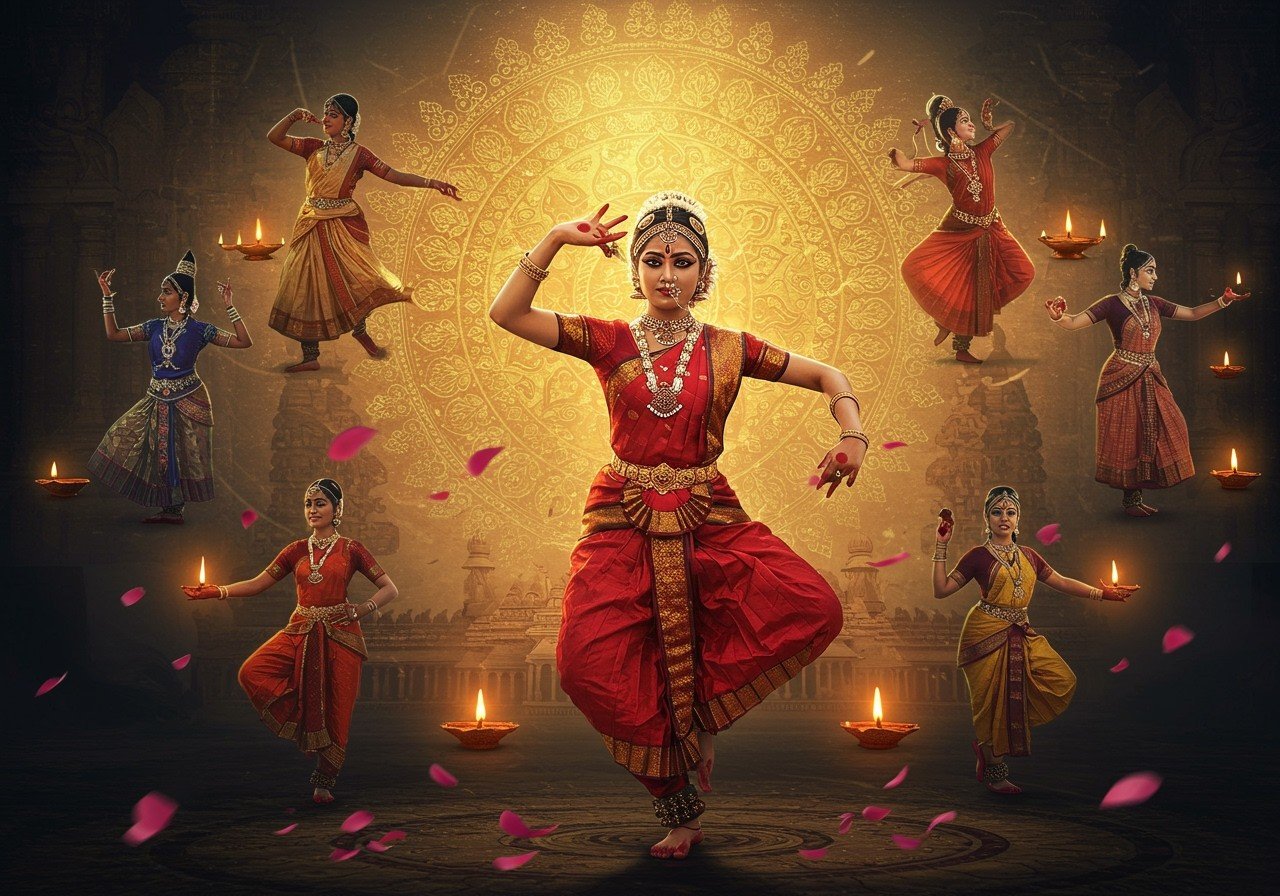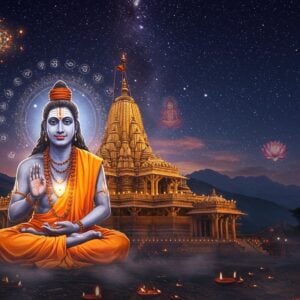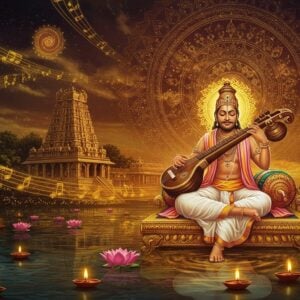Exploring the Elegance of Indian Classical Dance

Indian classical dance, also known as Shastriya Nritya, is a vibrant and integral part of India’s rich cultural heritage. More than just a performance, these dance forms are deeply spiritual, connecting the dancer to a larger tradition. By understanding the historical background and aesthetic principles, we can appreciate the role these dances play in both preserving and evolving cultural traditions in today’s world.
The Aesthetics of Indian Classical Dance
Indian classical dance is built on a foundation of aesthetic principles that create a rich and immersive experience. Key elements include Rasa (emotional essence), Bhava (expression), and Tala (rhythm). Together, they shape a unique artistic journey for both dancers and audiences.
The Natyashastra, an ancient Sanskrit text, serves as a guide for these dances, influencing how dance is understood and performed across India. Each dance form, such as Bharatanatyam, Kathak, and Odissi, showcases these principles in its own distinctive way, creating a diverse tapestry of artistic expression.
- Bharatanatyam: Known for its grace, precision, and fixed upper torso, Bharatanatyam originates from Tamil Nadu. It is characterized by intricate footwork, expressive hand gestures (mudras), and a captivating blend of rhythm and storytelling.
- Kathak: Originating from Uttar Pradesh, Kathak highlights intricate footwork, rapid spins, and expressive facial gestures. Often accompanied by live music, Kathak dancers create a mesmerizing interplay of rhythm and narrative, captivating audiences with their virtuosity and storytelling prowess.
- Odissi: Hailing from Odisha, Odissi emphasizes lyrical movements, sculpturesque poses inspired by temple art, and fluid transitions. Dancers express devotion and stories through graceful gestures and expressive eyes, creating an ethereal and captivating performance.
These dances not only entertain but also convey stories and emotions through their detailed expressions and complex rhythmic structures.
Indian Classical Dance Forms: A Diverse Tapestry
Rooted in ancient traditions, with the Natya Shastra as their guiding text, Indian classical dance forms reflect the diversity of India’s cultural landscape. The Sangeet Natak Akademi recognizes eight major dance forms, each with its unique characteristics and regional influences.
Bharatanatyam: Grace and Storytelling
Bharatanatyam, from Tamil Nadu, embodies grace and storytelling. Dancers use precise footwork, expressive hand gestures (mudras), and stylized facial expressions to convey emotions and narratives, captivating audiences with their elegance and precision.
Kathak: Rhythmic Footwork and Spins
Kathak, from Uttar Pradesh, is renowned for its intricate footwork, rapid spins, and dynamic storytelling. Dancers use expressive facial gestures and graceful arm movements to narrate tales, often accompanied by live music, creating an immersive and engaging experience.
Odissi: Lyrical Movement and Sculpture-Inspired Poses
Odissi, originating from Odisha, is characterized by its lyrical movements and poses inspired by temple sculptures. Dancers express devotion and stories through fluid gestures, expressive eyes, and a unique blend of grace and power.
Other Prominent Dance Forms
Kathakali and Mohiniyattam from Kerala, Kuchipudi from Andhra Pradesh and Telangana, Manipuri from Manipur, and Sattriya from Assam further enrich India’s vibrant dance tradition. Each form showcases distinct regional influences, techniques, and storytelling methods.
The Indian Ministry of Culture includes Chhau in its list, recognizing nine total classical dance styles. Scholars often include Yakshagana and Bhagavata Mela in discussions of this rich and diverse tradition. If you’re interested in learning more about dance forms from around the world, consider purchasing a book or watching a dance performance to gain a deeper understanding.
The Performance Categories: Nritta, Nritya, and Natya
All major classical Indian dances adhere to three performance categories as described in the Natya Shastra:
- Nritta: Focuses on pure dance, emphasizing rhythm, form, and technical skill. It is a non-narrative aspect of the dance, showcasing the dancer’s mastery of movement and rhythmic patterns. Nritta engages the senses of the audience through its visual beauty and rhythmic precision.
- Nritya: Combines rhythmic elements with expressive storytelling. Dancers use abhinaya (expression) through gestures, facial expressions, and body language to convey emotions and unfold the narrative. Nritya adds a layer of meaning and interpretation to the dance, engaging both the senses and the emotions of the audience.
- Natya: A complete dance drama, Natya combines Nritta and Nritya to present a full theatrical performance. It involves elaborate costumes, music, and often a complex storyline. Natya is a comprehensive art form that integrates all elements of dance, music, and drama to create a holistic and immersive experience.
These categories highlight the depth and complexity of Indian classical dance, where each performance is a blend of rhythm, expression, and storytelling, offering a spiritual connection to tradition.
Poojn.in: Supporting Indian Classical Dance Traditions
Poojn.in offers a wide selection of products that enhance the spiritual and aesthetic elements of Indian classical dance. For dancers performing pieces dedicated to deities like Maa Durga, Devi Saraswati, and Goddess Lakshmi, we provide authentic murtis (statues) and decorative items to create the perfect atmosphere for performances and practice spaces. Poojn.in is dedicated to providing high-quality products that support the rich traditions of Indian classical dance.
Our collection includes:
- Traditional bells and tulsi kanthi malas for dancers, adding an authentic touch to their attire and enhancing the spiritual significance of their performance.
- Brass and copper items for stage decoration, creating a visually appealing and culturally relevant backdrop for performances. For instance, a beautifully crafted brass Lakshmi murti can add a touch of elegance and reverence to the stage.
- Pure cotton wicks for arti ceremonies before performances, ensuring the rituals are performed with traditional materials and upholding the sanctity of the practice.
- Authentic incense and dhoop to create the right ambiance, enriching the sensory experience of the performance and fostering a sense of reverence.
- Puja items for seeking blessings before performances, enabling dancers to connect with their spirituality and seek divine guidance.
These items are carefully selected to meet the specific requirements of various classical dance traditions. Each product on Poojn.in is accompanied by detailed specifications and authenticity certificates where applicable. We ensure secure packaging and nationwide delivery to protect these sacred items.
Visit www.poojn.in to explore our comprehensive range of dance-related puja items and accessories. Our customer service team is available to assist you in selecting the perfect items for your specific dance form and requirements.
Embracing the Legacy of Indian Classical Dance
Indian classical dance is more than just movement; it is a living tradition that connects us to our cultural roots. Each form, with its unique style and stories, carries the legacy of generations past. As we witness these dances, we not only appreciate their artistic beauty but also honor a rich and profound cultural heritage.
Whether you are a seasoned performer, an aspiring student, or simply an admirer, these dances offer a gateway to a world where rhythm, expression, and devotion intertwine. Let us cherish and support this vibrant tradition, ensuring that it continues to inspire and enchant generations to come.
FAQs on Indian Classical Dance Aesthetics
What distinguishes Indian classical dance aesthetics? Indian classical dance aesthetics encompass the traditional principles of beauty, expression, and technique that define these art forms. This includes the intricate movements, stylized expressions, elaborate costumes, and evocative music that come together to tell a story and evoke specific emotions.
What sets Indian classical dance apart from folk dance? Indian classical dance follows strict rules and traditions passed down through generations, emphasizing structured choreography and specific techniques. Folk dance, in contrast, is more informal and varies regionally, often performed during festivals and celebrations without strict adherence to codified rules.
How does Indian classical dance differ from Western dance forms? Indian classical dance places significant emphasis on storytelling and abhinaya (expression) through stylized hand gestures (mudras), facial expressions, and body language. Western dance often prioritizes physical technique and dynamic movement, while Indian classical dance weaves narrative and emotional expression into the fabric of the performance.
What is the significance of expression in Indian classical dance? Abhinaya, or expression, is central to Indian classical dance aesthetics. It conveys the story, emotions, and underlying meaning of the dance to the audience. Dancers use their eyes, facial expressions, hand gestures, and body language to communicate the narrative and evoke specific emotional responses.
Which are the main forms of Indian classical dance? The eight major forms recognized by the Sangeet Natak Akademi are Bharatanatyam, Kathak, Odissi, Kathakali, Kuchipudi, Manipuri, Mohiniyattam, and Sattriya. Each form possesses unique stylistic elements and regional influences, contributing to the rich diversity of Indian classical dance.
How do costumes and makeup enhance Indian classical dance aesthetics? Costumes and makeup play a crucial role in enhancing the visual appeal and narrative of Indian classical dance. They are carefully chosen to reflect the specific dance form, character being portrayed, and mood of the performance, adding depth and dimension to the storytelling.
Can Indian classical dance be learned online? Yes, numerous dance schools and instructors now offer online classes in Indian classical dance. These virtual platforms provide accessible learning opportunities for students worldwide, enabling them to learn and practice under the guidance of experienced teachers from the comfort of their homes. Consider checking out online resources and platforms dedicated to Indian arts and culture for reputable online dance classes.
What role does music play in Indian classical dance aesthetics? Music is an integral element of Indian classical dance, setting the rhythm, mood, and emotional tone for the performance. Traditional instruments and vocal music accompany the dance, guiding the dancer’s movements, expressions, and storytelling, creating a seamless and evocative artistic experience.


